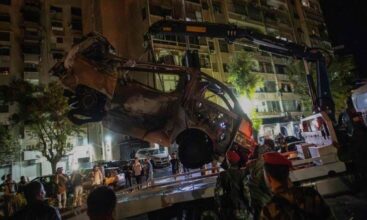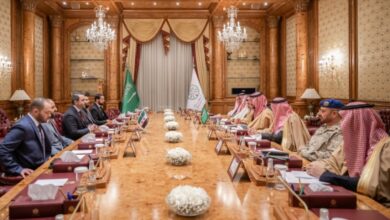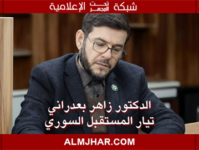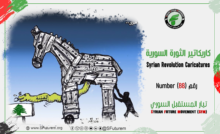Symbols and Figures of the State in Syria (17): Saadallah al-Jabiri
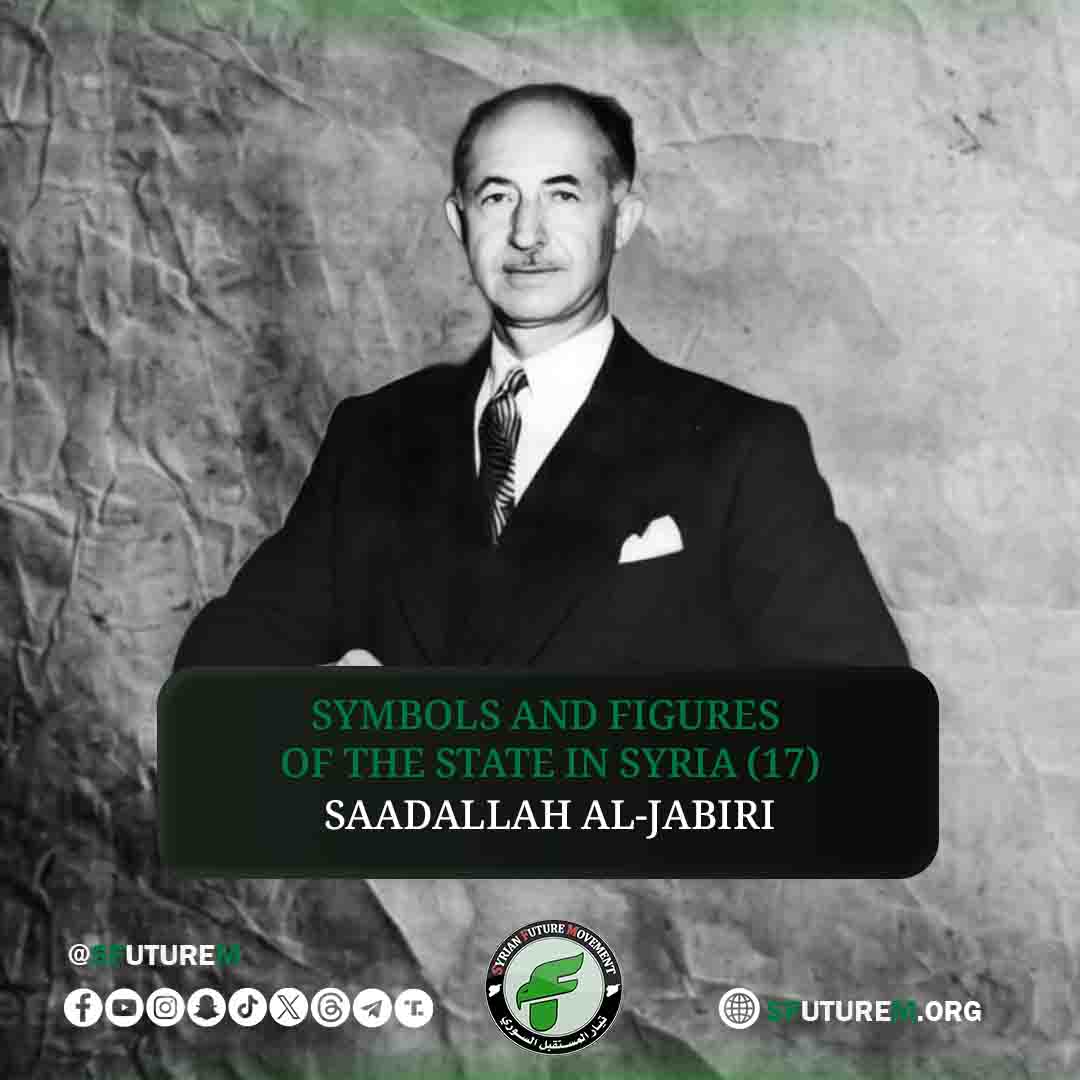
- Born on October 14, 1892, in Aleppo, to a distinguished family known for its patriotism, piety, and wealth.
- His father, Al-Hajj Abdul Qadir Lutfi Al-Jabri Al-Husseini, was the Mufti of Aleppo Province, the son of Sheikh Murad, and grandson of Hajj Abdul Qadir, the Mufti and leader of Aleppo’s noble families.
- After completing his high school studies in Aleppo, his brother Ihsan Al-Jabri brought him to Istanbul to continue his education at the Royal Imperial College.
- He connected with Arab youth in Istanbul, where they founded the Young Arab Society and swore an oath to work toward Arab rights.
- He was sent to Germany, studied there for two years, and returned to Istanbul.
- With the outbreak of World War I, he was conscripted into the Ottoman army as a junior officer and assigned to oversee food supplies and convoys in the town of Erzurum, spending the war there.
- After the war, he returned to Aleppo and joined the human rights movement.
- During the 1919 revolutions in response to the Allies’ plans to divide Arab lands and the French entry into Syria, he supported and collaborated with Ibrahim Hanano, the leader of the northern uprising.
- He reconnected with fellow patriots from the Imperial College, such as Shukri Al-Quwatli and other nationalists.
- He participated in the Syrian General Congress of 1919-1920, advocating for the unity of natural Syria.
- Due to his resistance to the French, he was imprisoned in Arwad alongside Hashim Al-Atassi and other patriots.
- Al-Jabri and his group held meetings, filed complaints, and sent petitions to the League of Nations, denouncing French actions.
- When the French authorities announced plans to establish a constitutional government, the nationalists decided in their congress to participate in the elections. After Ibrahim Hanano and Al-Jabri were elected to the first Constituent Assembly, the French dissolved it, prompting the nationalists to resume their struggle with protests and demonstrations, leading to Al-Jabri’s re-arrest.
- Upon his release, the nationalists drafted the National Bloc’s charter with Hashim Al-Atassi as President and Ibrahim Hanano and Saadallah al-Jabiri as Vice Presidents.
- When the National Bloc rejected the 1933 treaty, protests erupted across Syria, resulting in the arrest of nationalists, including Al-Jabri, who received an eight-month prison sentence.
- French tyranny intensified, with offices of the National Bloc closed, and widespread arrests in Aleppo, Damascus, and other cities. The people went on strike, and Al-Jabri was arrested again and exiled to Ain Diwar.
- The French summoned the nationalists and agreed to send a delegation to France to negotiate a treaty, with Al-Jabri as a member. A general amnesty was issued for Syrians, leading to the release of nationalists and the signing of the 1936 treaty.
- He served as Minister of the Interior, then as Minister of Foreign Affairs in Jamil Mardam Bey’s government under President Hashim Al-Atassi.
- However, French-instigated sectarian strife led to the suspension of the constitution and the end of that government, with the resignation of the President, marking the end of the national era.
- With the constitutional system dismantled and nationalists barred from power, the French intensified their oppression and established a compliant government. In this context, Al-Jabri and others were forced to flee to Iraq as refugees after Dr. Abdul Rahman Al-Shahbandar’s murderer was promised amnesty if he accused National Bloc leaders Shukri Al-Quwatli, Saadallah Al-Jabri, and Jamil Mardam Bey of instigating the murder, though they were ultimately acquitted.
- He returned to Syria only after British forces and the Free French Army entered Syria, announcing its independence.
- After Shukri Al-Quwatli was elected President on August 17, 1943, Al-Jabri headed his government. This administration’s national stance led to the French aggression against Syria in 1945.
- Al-Jabri led the Syrian delegation in signing the Alexandria Protocol and chaired its delegation at the preparatory committee for the Arab League.
- He attended the founding of the Arab League.
- Al-Jabri was elected multiple times as a Member of Parliament for Aleppo, was frequently detained by the French, served as Minister of Foreign Affairs and Interior, and was Prime Minister. He was also Speaker of the Syrian Parliament in 1945.
- He ordered the dissolution of a parliamentary session on May 29, 1945, moments before French forces attacked, saving the deputies’ lives.
- When French forces learned the parliament members had escaped, they attempted to arrest Al-Jabri at the Orient Hotel. Disguised as a monk, he fled with the help of the Russian ambassador, reaching Haifa, from where he telegraphed London and the Security Council. This prompted British forces to intervene in Syria, and on April 17, 1946, British tanks entered Damascus, a date celebrated as Syria’s Independence Day, largely due to Al-Jabri’s efforts.
- The French evacuated Syria on April 17, 1946, marking the departure of the last French soldier, and Syrians celebrated their leaders of the National Bloc, led by Al-Jabri.
- During his final visit to Egypt in 1947 for an Arab League meeting, he fell ill with hepatitis, likely contracted during his repeated imprisonments.
- Upon President Shukri Al-Quwatli’s request, he resigned as Prime Minister due to his illness.
- He returned to Aleppo, where he passed away in June 1947 at age 54.
- He devoted his life to the struggle, remaining unmarried and without children, selling all his possessions to fund his long-standing fight.
- Aleppo honored him with a grand procession, led by the President, the Prime Minister, ministers, parliament members, and crowds from various organizations.
- He was laid to rest beside his comrade, Ibrahim Hanano.
- President Al-Quwatli mourned him with a moving tribute, recounting their shared journey since their student days, celebrating his noble character and contributions.
- Prime Minister Jamil Mardam followed with a speech highlighting Al-Jabri’s sacrifices in securing Syria’s independence and pride.
- The funeral was attended by royal delegations representing King Farouk and King Abdulaziz Al Saud, Arab League leaders, ministers, consuls, political representatives, Syrian organizations, and masses of mourners.
In the Syrian Future Movement, as we commemorate the memory of the founders of Syria, we bring forth one of Syria’s influential figures and a prominent symbol of the early Syrian state who played a significant role in shaping its structure, the architect of Syrian independence, “Saadallah al-Jabiri.” This is part of a sequential feature we present to highlight the symbols and figures of the Syrian state, with a desire to connect our modern revolutionary present with a steadfast past and historical milestones. Our hope is to inspire within our people the need to build and cultivate true statesmen. We seek to learn from their experiences, overcome their shortcomings, and build upon their history, so we may preserve the homeland, safeguard its achievements, and restore Syria’s dignity and glory after years of oppression, tyranny, and corruption.
